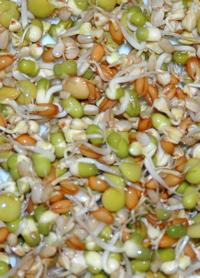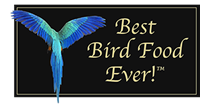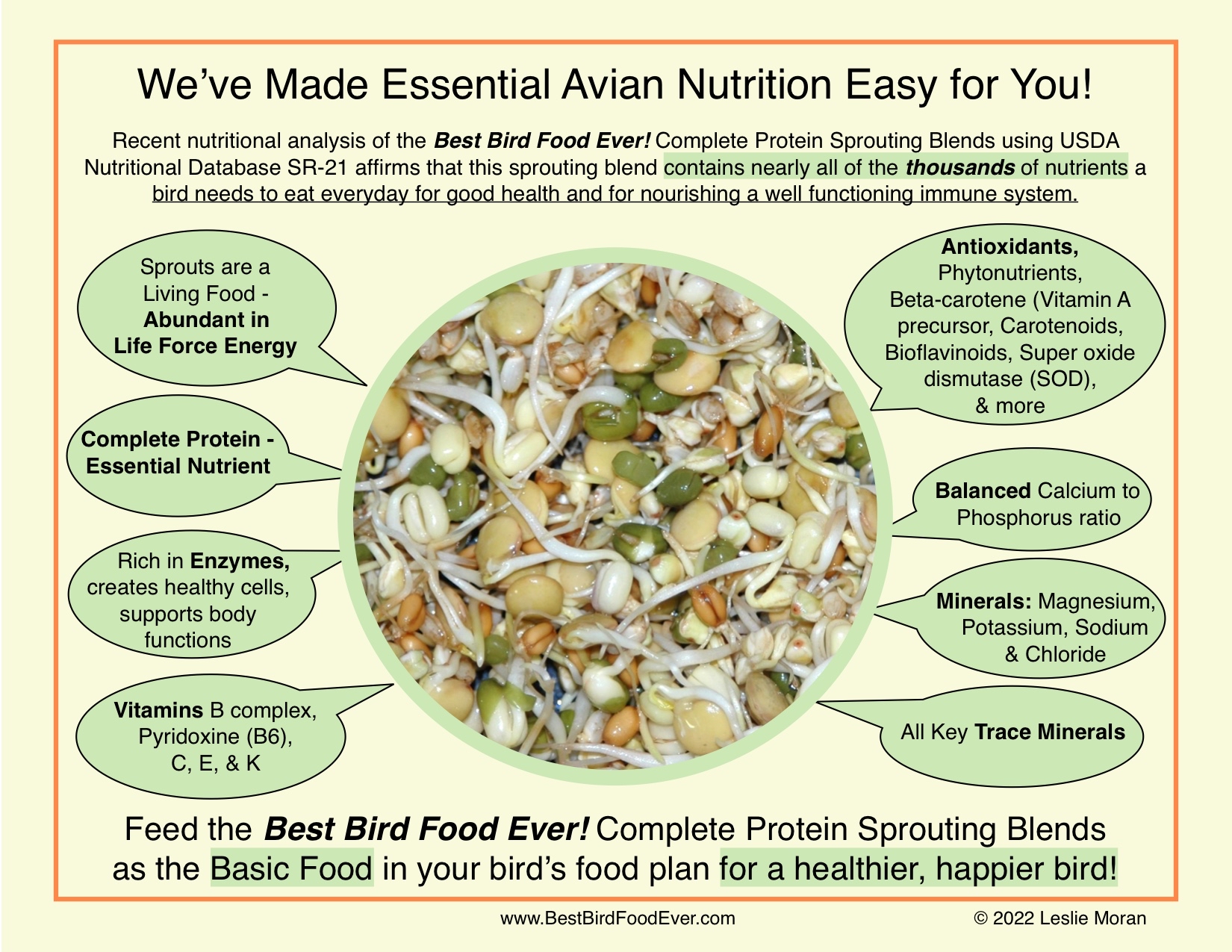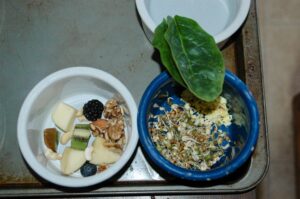One Study
In the published paper, “Estimated nutrient content of diets commonly fed to pet birds”, by L Hess, DVM, G Maudlin, DVM, MS and K Rosenthal, published in the Veterinary Record, 2002, the caretakers of 135 companion birds were surveyed using a questionnaire. Participants kept track of the foods their birds ate for a week. The birds in this study were placed in one of six groups depending on the foods fed.
.
Diets Fell Short on Nutrition
The foods these birds ate included seeds, nuts, pelleted foods, fresh fruits, fresh or steamed vegetables, cooked ‘people foods’ such as pasta, grains and beans, bread products, cookies, birdie bread, cooked eggs, yoghurt and cheese. Sprouts – of any type – were not included in this study.
The majority of birds in this study, 89 out of the total 135, consumed less than 25 percent of a formulated product, or were fed a combination of dry seed and ‘human foods’. When the median individual nutrient content of these food groups was compared with published avian dietary requirements many discrepancies were found.
This study only reviewed the nutrients: protein, vitamins D3, A, E, calcium, phosphorus and fats. However, what my research, my birds and my client’s birds have taught me is that the essential nutrients for avian good health and wellness encompasses a much more comprehensive list that what was included in this study.
.
♦My Must Eat List
Avian nutrients my parrots and finches eat everyday include: Fresh Filtered Water, Complete Protein, Enzymes, Healthy Carbohydrates, Fats (balanced amounts of Essential Fatty Acids), Antioxidants, Vitamins (A,B complex,C,D,E and K), and Minerals (macro-minerals and trace minerals).
.
How Our Bird Feeding Customs Fall Short on Nutrition
Common Avian Nutrient Deficiencies
♦Protein
80 percent of the birds in the study consumed less protein than recommended for basic body maintenance. Proteins are essential nutrients required for growth and development, and are vital for the maintenance, repair and regeneration of every cell in the body. The quality and amount of protein consumed has an impact on every cell in the body and every bodily system. The protein in a bird’s diet plays a major role in building and supporting a healthy and well-functioning immune system.
♦Vitamin D3
98.5 percent of the birds in the study consumed less vitamin D3 than recommended for basic body maintenance. This vitamin is essential for the proper absorption of calcium
♦Vitamin A
Clarification: Vitamin A is a fat soluble vitamin found only in animals products such as liver and fish oil (cod liver oil). Then there are the vitamin A precursors, the most commonly known is the antioxidant beta-carotene, also called provitamin A, B-carotene, Betacarotenum or Trans-beta-carotene.
Beta-carotene can be converted to Vitamin A in a healthy liver.
In the study being discussed here 58 percent of the birds had deficiencies of vitamin A when amounts were compared to the recommended levels for basic body maintenance. The study also states that a certain percentage of birds that ate beta-carotene rich foods consumed more than 10 times their maintenance requirements of vitamin A. But, this statement is not accurate.
It’s not accurate because the researchers did not take in to account the body’s natural wisdom of being able to determine the proper amount of beta-carotene that is actually converted into vitamin A. According to the University of Maryland Medical Center, the body only converts as much vitamin A from beta-carotene as is needed.
Vitamin A supports eye health and is essential for good vision, nourishes a healthy immune system and is required for proper cell function and growth.
♦Vitamin E
21 percent of the birds in the study consumed less vitamin E than recommended for basic body maintenance. This essential nutrient is a powerful antioxidant that helps support the brain, and the cardiovascular and respiratory systems.
♦Calcium
In this study nearly all the birds involved – over 95 percent – consumed diets containing less calcium than recommended for basic body maintenance.
In the avian body, calcium is the predominant mineral in the skeletal system. Calcium is also contained in the body fluids where it plays an essential role in blood coagulation and membrane permeability, while maintaining normal functioning of the heart, muscles and nerves. Calcium absorption occurs mainly in the upper small intestine, being regulated by vitamin D3 and dependent on proper amounts of phosphorus being present.
♦Phosphorus
In this study being discussed nearly 93 percent of the birds consumed less than adequate amount of phosphorus. This mineral is vital for optimal calcium absorption and is an important structural component of the bones. Phosphorus is essential for a wide range of biological functions in the body.
♦Calcium to Phosphorus Ratio
When consuming minerals – balance is the key. Either too much or too little of a certain mineral can cause a nutritional disorder, a metabolic imbalance or nutritional deficiency. The balance of the calcium to phosphorus ratio in a parrot’s diet is very important. This ratio determines how much of each of these macro-minerals can be absorbed by the body. The ideal calcium to phosphorus in the avian body is 2:1, two-parts of calcium for every one-part of phosphorus.
Because of the extremely low amounts of calcium and phosphorus consumed by nearly all of the birds in this study we can interpret that these parrots were not able to absorb even the minimum amount of calcium and phosphorus required for maintenance of related essential bodily functions that depend on these two minerals.
.
Common Avian Nutrient Excesses
♦Fats
In this study no distinction is made between essential fatty acids, and other categories of fats. It only refers to fats as a general term.
In the two group of birds in this study that mainly ate a combination of dry seed and ‘human foods’ we found two alarming facts.
In one group 77 percent of the birds ate more than TWICE their maintenance requirements of fat.
And, in the other group 59 percent of the birds ate more than THREE TIMES their maintenance requirements of fat.
Excessive fat intake is a primary cause of obesity. The Harvard School of Public Health explains that consuming excessive amounts of fat can cause diabetes (type 2 in people) and numerous cancers. Many research papers also cite that the omega-6 fatty acids (O-6 amounts are very high in seeds) has been linked to causing chronic inflammatory diseases such as osteoporosis, depression, macular degeneration, multiple sclerosis, infertility and other chronic poor-health issues.
Specific published research papers, cited below, have documented increases in chronic inflammatory diseases such as nonalcoholic fatty liver disease, cardiovascular disease, obesity, inflammatory bowel disease, rheumatoid arthritis, and Alzheimer’s disease directly linked to high O-6 levels in the foods being eaten.(1)(2)
♦Essential fatty acids
Essential fatty acids (EFAs) are required for proper growth and development. EFAs are essential for life and must be consumed in the diet because they cannot be made in the body. Every living cell in the body needs EFAs.
.
Focus on the Solution:
Giving Your Birds the Essential Nutrients is Easy
Instead of discussing all the health risks and problems that are directly linked to the nutritional dietary deficiencies discussed above, I’m going to focus on the solutions so you can start getting rid of these nutritional deficiencies and imbalances when feeding your flock.

♦Complete Protein
Sprouting and feeding our Best Bird Food Ever! (BBFE) Complete Protein Sprouting Blends is a simple and easy solution to providing your birds a natural source of complete protein that also contains nearly all of the hundreds of nutrients a parrot or finch needs to eat everyday for good health. You can also cook the BBFE and serve it as a mash. For a chart showing all these nutrients please see the link immediately below.
♥♥♥ Link: WE’VE MADE ESSENTIAL AVIAN NUTRITION EASY FOR YOU.
.
.
♦Vitamin D3
This nutrient is also called the sunshine vitamin. By providing your birds full spectrum lighting directly overhead, you can easily meet this need. The research paper discussed in this article does not mention using proper lighting to provide this essential nutrient for your birds. Proper lighting is a very simple fix for this common nutritional deficiency.
♦Vitamin A
Our BBFE sprouting blends provide abundant amounts of beta-carotenes. See link to WE’VE MADE ESSENTIAL AVIAN NUTRITION EASY FOR YOU. ♥♥♥
♦Vitamin E
Our BBFE sprouting blends provide ample amounts of vitamin E. See link to WE’VE MADE ESSENTIAL AVIAN NUTRITION EASY FOR YOU. ♥♥♥
♦Calcium and Phosphorus
Our BBFE sprouting blends provide a balanced ratio of calcium and phosphorus. See link to WE’VE MADE ESSENTIAL AVIAN NUTRITION EASY FOR YOU. ♥♥♥
MY PROMISE –
I’M MAKING BALANCED & WHOLESOME AVIAN NUTRITION EASY FOR YOU!
AND DELICIOUS FOR YOUR FLOCK.
I hope the information in the article helps you feed your birds healthier foods.
To the best of health for your flock!
![]()
Resources:
(1) ‘Health Implications of High Dietary Omega-6 Polyunsaturated Fatty Acids’, E Patterson, R Wall, GF Fitzgerald, RP Ross and C Stanton, Journal of Nutrition and Metabolism, 2012.
(2) “The importance of the ratio of omega-6/omega-3 essential fatty acids”, The Center for Genetics, Nutrition and Health, Washington, DC 20009, USA. Biomedical & Pharmacotherapy, 2002 Oct;56(8):365-79.
If you enjoyed this post, found it valuable, or have a question,
please submit a comment.
.
I LOVE YOU









Is there any info on the quantity of each food offered to the birds each day in the study. We all know birds will pick and choose what they like or looks good. I can’t help thinking that given the variety of the foods offered and amount a bird eats in a day,this study was bound to show problems.
Hi Chris,
Thanks for your comment.
Here’s the info in the study that describes the quantity of the foods eaten. My comments are below.
From the study:
“The questionnaire was prepared according to established techniques used by human dietitians. It asked specific questions about the quantity of food consumed (in teaspoons, tablespoons, cups, or individual pieces or slices of foods such as potato chips*, bread, cookies* and nuts) and the preparation (cooked versus raw) of 106 named human foods, plus mixed bird seeds and nine commercially formulated products. The owners were asked to estimate visually the amount of foods their birds consumed during the week, and not the amount of food they were offered.”
“The percentage of seeds, human food and formulated product that each bird ingested was calculated from the amounts of the various foods their owners estimated they consumed. Any named food other than seeds or a formulated product was defined as a human food. The birds were then divided into six food groups according to the amounts of seeds, human foods and formulated products their diets were calculated to contain.”
*************
The information in the published paper does not include the details of the research data that would include how much of every food each bird in the study ate.
You make two excellent point, Chris. Because:
1. The birds were fed a random variety of foods, and
2. Because they eat such a tiny amount of food, when compared to how much food a person eats.
Because of these two areas you comment the study was destined to show problems.
For these two reasons I think is so vital to ensure that our parrots eat a balance of nutrient dense foods, such as our well-formulated sprouting blend, so they are guaranteed to receive all the hundreds of essential nutrients they must eat everyday for their good health. When eating this type of food, a small amount goes a long way in meeting a bird’s daily nutritional needs.
My upcoming avian recipe book will give all the details of how easy it is to feed a balance of wholesome foods that ensure a bird receives all my Must Eat list of nutrients above. Stay tuned.
If you’d like more info on when my avian recipe book will be available sign up for our email Newsletter, on the right side, near the top of this page.
Note* I don’t consider potato chips or sugar laden cookies healthy food choices for parrots (or people). Yes, comfort foods are an important part of anyone’s diet – parrot or person. To give you a taste of some of my favorite comfort foods, my recipe book will include healthy (and yes tasty) versions of these favorites.
If your bird has a favorite comfort food you’d like a healthier option for, let me know I’ll see what I can do to include some alternatives in the book.